Unit 9: Scale and Harmony
Synopsis
The word “harmony” has several connotations: in everyday speech, it suggests that things have been arranged in an orderly, pleasing fashion, while in music, it can refer to the sounding together of multiple notes, pleasing or not, or to more complex notions of how different harmonies relate to each other in a structural way. A scale is a closely related notion and refers to the collection of notes from which harmonies in a harmonic system are constructed. Scales and harmony are closely related to intonation, or the way in which we tune the different intervals of a scale. The most common system in Euro-American music today is called twelve-tone equal temperament, in which the octave is divided into twelve equal parts, however, there are many different systems in use around the world, and that have been used by different cultures throughout history.
Introduction
In this unit we will look at scales and harmony from the perspective of perception and cognition of music. In units 4 and 5 we have already learned about consonance and dissonance as well as pitch, intervals and key areas. Harmony is beased on those principles, e.g. we expect chords to have low sensory consonance and we also are keenly aware of when chords don’t seem to fit in a passage of music.
Webster’s dictionary defines harmony in reference to music as (1) the combination of simultaneous musical notes in a chord, (2) the structure of music with respect to the composition and progression of chords or (3) the science of the structure, relation, and progression of chords. In more general terms, harmony also denotes the pleasing or congruent arrangement of parts.
As we can see from the above definition, the word harmony often refers to either a chord, a progression of chords, or a consonant (or generally speaking, pleasing) sonority. The task of defining harmony is a difficult one — is it a chord or a progression of chords? How are harmony and harmonic progression different from timbre and timbral evolution? In this unit, we will discuss these questions and look at how composers in the 20th and 21st centuries view harmony. We will also look at the effects that tuning systems have on harmony.
Scales (derived from Italian scala meaning “staircase”) are the collection of pitches, harmonies and melodies are formed from. They usually span the interval of an octave and repeat when going beyond it. The pitch of the individual tones within a scale depends on a variety of factors which have undergone changes throughout history as composers focussed on aspects such as pure sonorities or being able to modulate to distant key areas. It turns out that using 12 pitches per octave is the result of a compromise, but there has been an interest throughout history to consider scales with fewer or many more pitches per octave or other intervals. The deviation from the standard is usually referred to as microtonality.
Historical View of Scale and Harmony
The term harmony comes from a Greek word that translates literally as “means of joining” and is related to the word for joint or shoulder. In ancient Greek music, the term referred to the juxtaposition of different elements, but since the musical practice of the time did not include the simultaneous sounding of multiple notes, this concept was only used as a way of discussing the theoretical relationships between pitches. In the Medieval period, composers began to write music in which two notes that formed a perfect consonance (fourths, fifths, or octaves) were sung simultaneously, and in the Renaissance Gioseffo Zarlino wrote of triadic harmony that included the imperfect consonances: thirds. These descriptions pertain only to the structure of an isolated simultaneity, although it is clear that as far back as the 15th century, theorists understood the concept of harmony to encompass not only the relationships between simultaneously sounded pitches, but the relationships between chords. Additionally, some theorists have considered harmony to be the progression through, and alternation of, consonant and dissonant sonorities.
The distinction between harmony and harmonic progression is an important one. Consider, for example, the C major chord in figure 1.
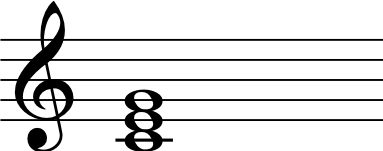
In the key of C major, this chord has a feeling of stability since it is the tonic of the key. However, in the key of F major, the same chord will sound less stable as if it should move to F. As we can see, the context in which a chord appears is important. Another example is the famous “Tristan chord”—the opening harmony of Richard Wagner’s opera Tristan und Isolde (figure 9.3). The nature of this sonority has been debated for decades, but the debate centers less around the chord itself, and more around the function and way in which it resolves.

|
| |
(Audio source: Simon Schindler & Fulda Symphonic Orchestra)
The chord can easily be explained as a half-diminished seventh chord or as a French augmented 6th chord where the G# is an appoggiatura to the A, however, the way in which it resolves calls these labels into question.
Tuning and Temperament
Since the time of J.S. Bach, equal-temperament has increasingly dominated Western classical music. In this system, every semitone is of equal size in log-frequency (remember that our perception of pitch is logarithmic). For a given number of semitones, $n$, we can calculate the frequency from a reference $f_r$ using the formula
\begin{equation} f_n=f_r(\sqrt[12]{2})^n \label{eq:Equal-Temperament} \end{equation}
Although a thorough discussion of tuning is beyond the scope of this unit (Wikipedia has numerous pages and links devoted to the topic), we can say a few things about equal temperament and the systems that it replaced.
Any tuning system must be measured against just intonation in which intervals are calculated by integer ratios, e.g. a just fifth is $3/2$, a just fourth is $4/3$, and a just major third is $5/4$. Although the just intervals are considered by many to be the most pleasing, they can lead to complex problems. For example, a just major third above A1 (55 Hz) is 68.75 Hz, but if we use 55 Hz (A1) as our reference frequency and calculate a C#1 by going up in fifths, we arrive at 69.609375 (55 • 1.5 = 82.5 (E2) • 1.5 = 123.75 (B2) • 1.5 = 185.625 (F#3) • 1.5 = 278.4375 (C#4) / 4 = 69.609375). One solution to this problem is to tune certain keys as perfectly as possible and allow other more distant keys to be out of tune. Equal temperament solves the problem by making every interval (with the exception of the octave) slightly out of tune. For example, in the case of perfect fifths, in equal temperament,
\begin{equation} 55(\sqrt[12]{2})^7 = 82.4069 \end{equation}
and in just intonation,
\begin{equation} 55\cdot(\frac{3}{2}) = 82.5 \end{equation}
An important technique that defines common practice music is the modulation to distant keys. As the harmony moves away from the home key, tension increases, however, in a tuning system where the tonic key is tuned near just intonation and the degree to which a key is out of tune increases with the distance from the home key, modulation to distant keys results in a higher level of tension. In the following listening example, you will hear the first minute of a Capriccio (FbWV 506) by Johann Jakob Froberger (1616-1667) played on an organ tuned to meantone temperament). In the second listening example, you will hear the same passage, but played in equal temperament.
|
| |
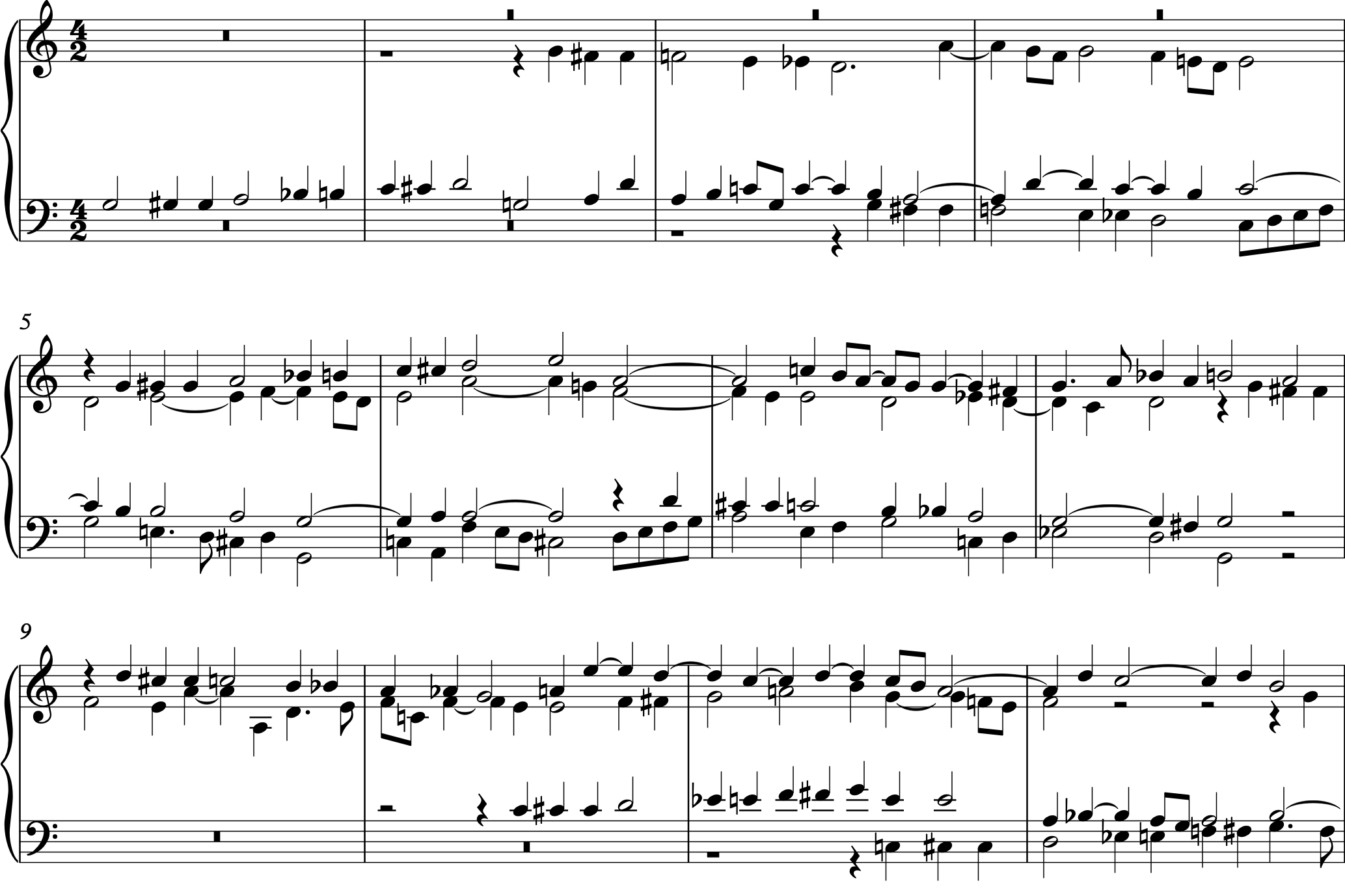
Figure 2. Bars 1-12 of Capriccio (FbWV 506) by Johann Jakob Froberger.
you can have access to all MUTOR interactive maxpatches when you download the MUTOR github repository inside the maxpatches folder.
Period Tunings
Theorists have created tunings from either deriving them from the overtone series (just-intonation tuning) or stacking fifths (Pythagorean tuning). Stacking four fifths on C leads to an E which is considerably sharper (81/64; 408 cents) than the E contained in the overtone series (5/4; 386 cents). This discrepancy - mathematically represented by the ratio 81/64 * 4/5 = 81/80 = 21.5 cents - is called the Syntonic comma. Since no tuning can exist mathematically where all thirds and fifths are just, musicians have attempted to make up for this by modifying either thirds and/or fifths — an approach referred to as temperament.
Meantone Temperament
During the Renaissance and Baroques periods meantone temperament was wide-spread: lowering fifths to keep the thirds as just as possible. A number of variants have been in use, e.g. quarter-comma and third-comma meantone temperament. The term quarter-comma, for instance, emphasizes the fact in this temperament the just fifth (3/2 = 701.96 cents) is lowered by an interval corresponding to a fourth of Syntonic comma (21.5 cents / 4 = 5.38 cents): 696.58 cents. Other temperaments suggested by Werckmeister, Valotti and many more are all geared towards allowing modulation to distant key areas while keeping thirds and fifth as pure as possible.
Many of these tunings and temperaments lead to tuning alternatives for a given key. For instance, in just intonation an Ab (8/5; going down by a just major third) is different from a G# (25/16; stacking two just major thirds). Hence, Keyboards such as the archicembalo built in 1588 have been constructed to represent tuning alternatives.
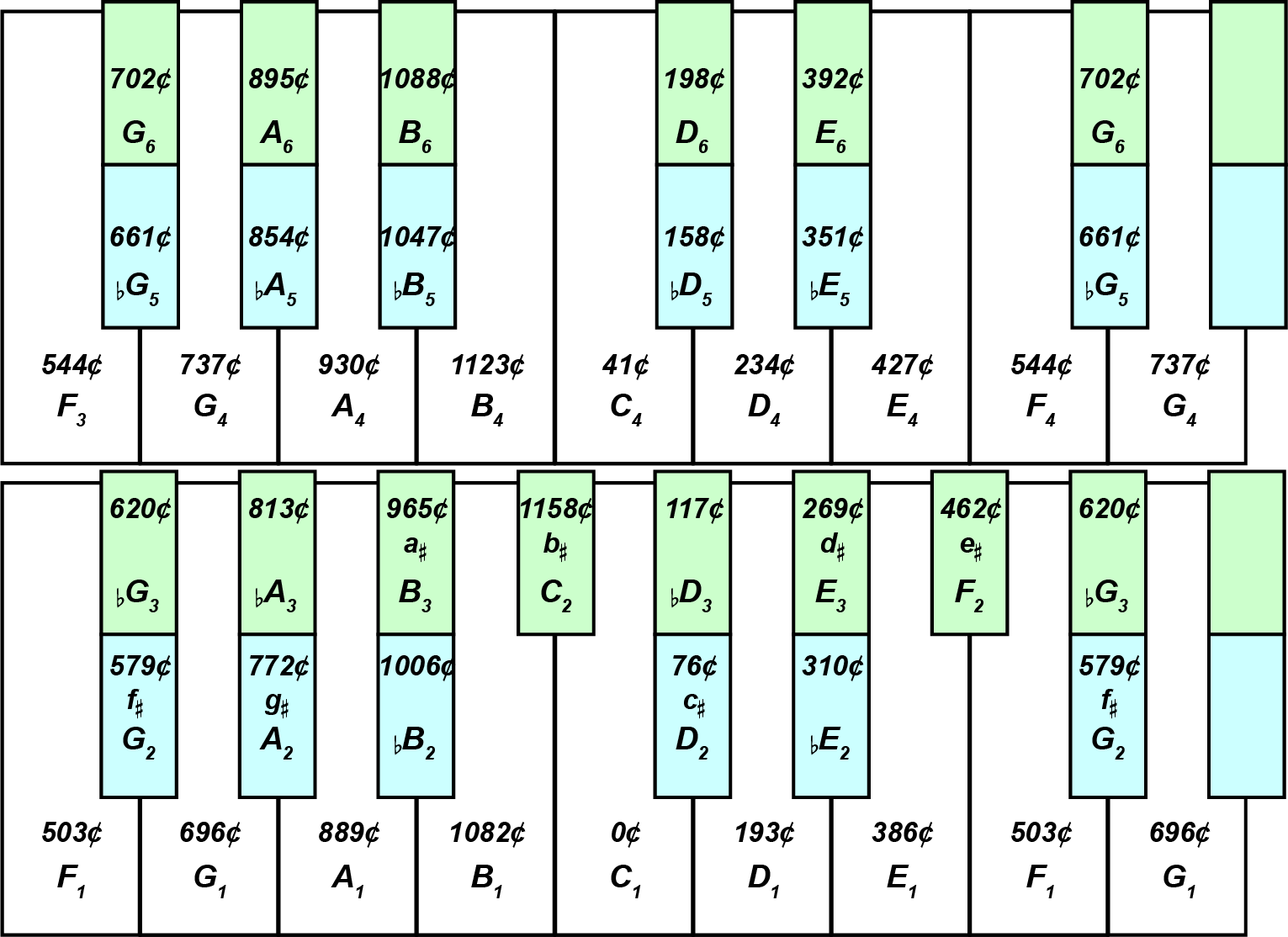
Equal Temperament
The ultimate compromise has been achieved by introducing 12-tone equal temperament - the tuning of choice in the Classical, Romantic and Modern periods. Here, the discrepancy between 12 just fifts and 7 octaves (Pythagorian comma; 23.46 cents) is tempered out by dividing up the comma evenly (23.46 / 12 = 1.96 cents) and applying this value to all fifths: 701.96 cents - 1.96 cents = 700 cents.
By tempering out fifths, the above-mentioned tuning alternatives become enharmonically equivalent, e.g. there is no longer a distinction between a G# and Ab. Due to equal temperament, approaches such as dodecaphony (invented by Arnold Schoenberg in 1923) and total serialism were developed, which treat all tones equally and subject them to mathematical set operations.
Ambiguity
We have already established that the role of a chord depends on its context. Changing this role facilitates modulation such as when the tonic triad of C major is being reinterpreted as the subdominant of G major - C major serving as a pivot chord between those two key areas. Via enharmonic equivalence, equal temperament adds another dimension to modulation as there is no audible distinction between the dominant seventh chord (e.g. G-B-D-F; a dominant in the key of C) and the German 6th chord (e.g. G-B-D-E#, a secondary dominant in the key of B). This ambiguity has been exploited by composers in the Classical and Romantic periods to quickly modulate to distant key areas. In the example below, Der Neugierige by Franz Schubert, Schubert exploits the harmonic ambiguity to create a musical analogy to the text by Wilhelm Müller: “One word is ‘yes’, the other is ‘no’; these two words contain for me the whole world”.

|
| |
(Audio source: Randall Scarlata & Jeremy Denk)

In the dominant seventh chord the dissonant F is resolved by downward motion (inwards) while in the German 6th chord the enharmonically equivalent leading tone E# moves up (outwards). This type of pivoting is comparable to the ambiguous cube illusion (featuring a type of a Necker cube) where a cube can either be perceived as projecting inwards or outwards.
Looking at figure 9.7 for an extended period of time or intermittently, the perspective of the cubes flips as the brain recognizes and realizes their ambiguity, but it can only represent one state at a time. In music, the harmonic frame of reference is given by the key area, forcing one state over the other. But by skillfully moving into the ambiguous sonority, the music prepares the listener for the flip and leads him/her to realize the other state in a context where the precise timing of the events also matters.
Microtonality
The term microtonality refers to the systematic exploration of relationships that cannot be derived from 12-tone equal temperament (12TET). In microtonal tunings, steps sizes or deviations from 12TET smaller than a semitone are common. Hence the term microtonality.
Amongst the practitioners of microtonality, we can distinguish at least two main schools of thought:
Just Intonation
Representatives of this movement, which American composer Harry Partch (Partch, 1979) had a large impact on, focus on intervals that can be derived from the overtone series and its inversion, the undertone series. Parth refers to this as O-Tonality and U-Tonality. In his music and theoretical writings, hitherto uncommon intervals such as 11/7 or 7/3 came to the foreground.
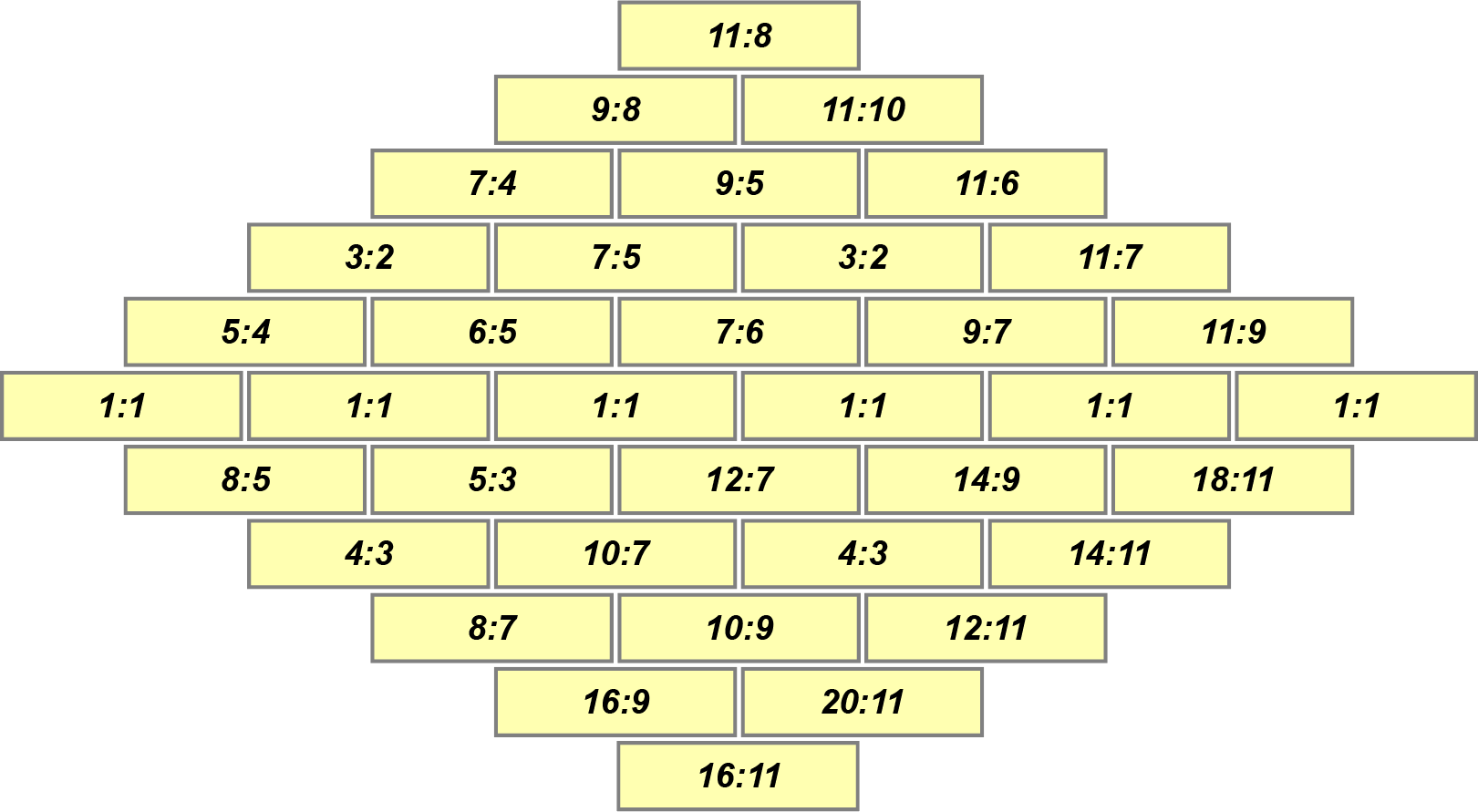
In Just Intonation (JI), we consider the relationships between prime numbers and their powers which can be geometrically arranged as lattices. The term n-limit Just Intonation refers to the prime number n up to which harmonic relationships are considered. In the medieval period, 3-limit JI (intervals derived from fifth relationships) was the norm, while during Renaissance 5-limit JI (adding thirds) became main-stream. In the 20th century, Partch added 7 and 11 for 11-limit JI and composers such as Marc Sabat and Wolfgang von Schweinitz have gone up to 23-limit and beyond. They also invented the Extended Helmholtz-Ellis Just Intonation notation capable of capturing JI relationships by means of specific accidentals.
In the 1980s, German musicologist Martin Vogel developed an electronic keyboard system, Mutabor, capable of retuning itself on the fly. As chords are thus always in tune, listeners will notice that the roots of the chords are shifting. Obviously, there is a trade-off between the purity of a chord and its stability in the linear, temporal dimension. Whether or not this is acceptable depends on the musical style. Jazz musician Jacob Collier, for instance, uses a similar on-the-fly tuning system developed at MIT which has created a deep interest in the contemporary Classical and Jazz communities.
Equal Divisions
Divisions of the Whole Tone
Subdivisions of the whole tone into four (quartertone tuning or 24-tone equal temperament [24TET] also known as equal devision of the octave in 24 steps [24EDO]), five (30TET) and six (36TET) were already theorized upon and practiced at the beginning of the 20th Century by composers such as Busoni, Hába, Wyschnegradsky and Ives. The 72-step “ekmelic” tuning - already used in Byzantine music theory - closely approximates 11-limit JI, while Mexican composer Julian Carrillo had a piano patented in 1940 with a keyboard in 16th notes (96TET) spanning just one octave, with a step size so small that playing a sequence of adjacent notes is perceived as a portamento.
Other Divisions of the Octave
In theory, the octave can be devided into an infinite number of steps. So what makes one scale more interesting than another? Obviously this depends on the style of the music and whether or not the music is meant to be performed on real instruments. One important aspect is how well the scale is capable of representing just intervals, e.g. small integer frequency ratios such as 3/2 or 5/4. Theorists seeking to find temperaments with even better fifths than 12TET have considered 41TET and 53TET. The latter is derived from stacking fifths and tempering out the small schisma between 53 fifths and 31 octaves. It was already known to Chinese scholars in antiquity.
you can have access to all MUTOR interactive maxpatches when you download the MUTOR github repository inside the maxpatches folder.
In turn, 19TET (approximation of 1/3 comma meantone tuning) and 31TET (approximation of 1/4 comma meantone tuning) feature excellent major thirds and have even been considered by 20th century scholars such as Joseph Yasser and Adriaan Fokker as contenders for the replacement of 12TET.
In 1980 American composer Easley Blackwood (Blackwood, 1982) wrote Twelve Microtonal Etudes for Electronic Music Media, the first systematic exploration of equidistant tunings from 13TET to 24TET.
Many tunings such as at 17TET, 19TET, 22TET, 31TET, 41TET and 53TET also feature a diatonic sub set of pitches and therefore be used as alternative tunings for tonal music.
These temperaments obey the following rule: 5 * m * s + 2 * n * s = 1200, where s is the step size of the temperament, and m and n are integers to be multiplied with s by to yield a diatonic whole tone or a semitone, resp.
The number of steps in the temperament (t) can be calculated by applying this formula: t = 5 * m + 2 * n.
In order to avoid unpleasant fifths, the following condition should also be met: 694 cents < (3 * m + n) * s < 710 cents.
Examples:
For 12TET: m = 2 and n = 1
For 17TET: m = 3 and n = 1
For 19TET: m = 3 and n = 2
For 22TET: m = 4 and n = 1
For 31TET: m = 5 and n = 3
For 41TET: m = 7 and n = 3
Divisions of Intervals Other than the Octave
The octave is a particular interval that creates a sense of unity with other other members of the same pitch class. Instead of the octave, other intervals can be used a frame for a repeating scale structure. Intervals that have been considered are the just fifth (3/2) and the just twelfth (3/1), the latter bearing a close similarity to the octave. Examples are the scales (alpha, beta, gamma and delta) invented by microtonal composer Wendy Carlos and the Bohlen-Pierce scale. In Elektronische Studie II, Karlheinz Stockhausen uses a scale dividing the just 5/1 interval into 25 steps.
Bohlen-Pierce Scale
The Bohlen-Pierce scale, first discovered and described in 1970s by German engineer Heinz Bohlen (and independently re-discovered by John Pierce and Kees van Prooijen) divides the just twelfth into 13 steps. The just version of the scale has a pitch set entirely made up of odd integer frequency ratios such as 5/3, 7/5, 7/3, 9/7 and 9/5. Some people also refer to this as 7-limit just intonation without 2 (a 3,5,7 pitch lattice). Remarkably, the equal tempered version of the scale matches the JI version more closely than the 5-limit (2,3,5) just and equal tempered versions of the chromatic scale match each other.
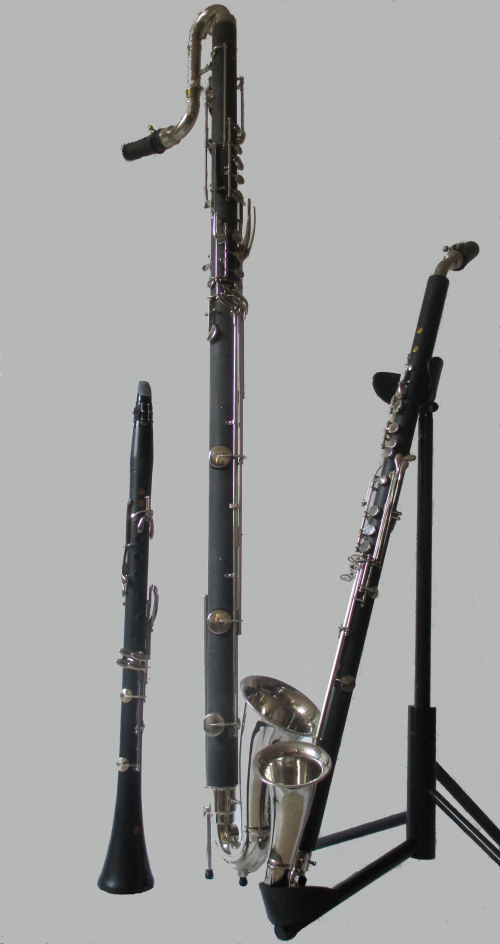
Odd integer frequency ratios arise in the spectrum of the clarinet, which is one of the few wind instruments that blow over at the twelfth. What could be more appropriate than developing a clarinet with the Bohlen-Pierce tuning? In 2004, the Hamburg University of Music and Drama (HfMT) instigated the Bohlen-Pierce Clarinet project focussing on the design of particular Bohlen-Pierce clarinets in close collaboration with Canadian clarinet maker Stephen Fox, with the first clarinet being finished in 2007. In this context, Müller, Orlandatou and Hajdu, (Müller et al., 2014) have proposed a novel music theory based on the specifics of the scale, including new note names (N - Z), new clefs, a chromatic six-line staff (with no need of accidentals) as well as the establishment of a BP theory of harmony, counterpoint and ear training (see figure 9.10 for different representations of the Bohlen-Pierce scale). MUTOR co-author Psyche Loui, in her Ph.D. work, has asked the question whether or not humans can rapidly learn grammatical structure in a new musical scale. She used the Bohlen-Pierce scale as a point of departure and had, from the perpective of a cognitive psychologist, encouraging results which were in line with the outcomes of the empirical research conducted at the HfMT.
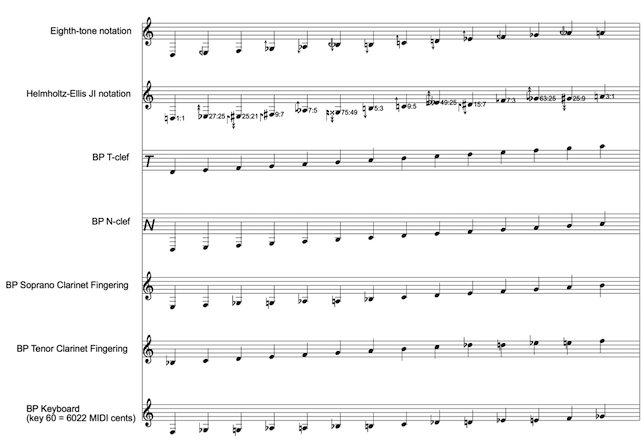
A CD released by the HfMT in 2020 also contains an arrangement of a piano composition, Vers la flamme, by Alexander Scriabin for Bohlen-Pierce ensemble. Scriabin’s harmonic language in his last period focusses on the minor-third circle and tritone relationships as a replacement for Western functional harmony. As the Bohlen-Pierce scale features the consonant tritone (7/5) and minor third (25/21), composed of four or two scale steps, resp., it provides an ideal harmonic framework for such an endeavour.
|
| |
Bohlen-Pierce Microtonality
As the equal-tempered step size of the Bohlen-Pierce scale is 146.3 cents, it is often referred to as a macrotonal scale, implying that its step size is larger than a semitone. But just like semitones of the chromatic scale, the Bohlen-Pierce scale can also be devided into smaller fractions. Two microtonal scales stand out: The Bohlen-Pierce triple scale dividing the BP step into 3 and the Bohlen-Pierce quintuple scale dividing the BP step into 5. Serendipitously, the resulting step size (1902 / (13 * 5) = 29.262 cents) is nearly identical to 41TET (1200 / 41 = 29.268 cents). We can therefore consider the Bohlen-Pierce a subset of 41TET. This fact has far-reaching implications which have barely been exploited by composers and theorists.
Other Scales
Another classes of tunings cannot be classified into neither group. It includes the Indonesian pelog (used in gamelan music), which has a set of 5 small and 2 large unequal intervals, of which only 5 are used in traditional gamelan music. According to William Sethares (see below) these instruments are tuned in such way that sonorities formed from the inharmonic sounds of the Gamelan orchestra strive for low sensory dissonance. To smooth out the unpleasantness of the inharmonic sounds is the pair-wise performance of instruments tuned to slightly different pitch which creates vibrato-like beatings. Also note that each Gamelan orchestra has its slightly specific tuning which is due to differences in the manufacturing of the instruments. Therefore, any frequencies given for the pelog scale are either orchestra-specific or abstractions of real tunings. (The other scale commonly used in gamelan music, slendro, is characterized by a quasi-equidistant 5-tone scale.)
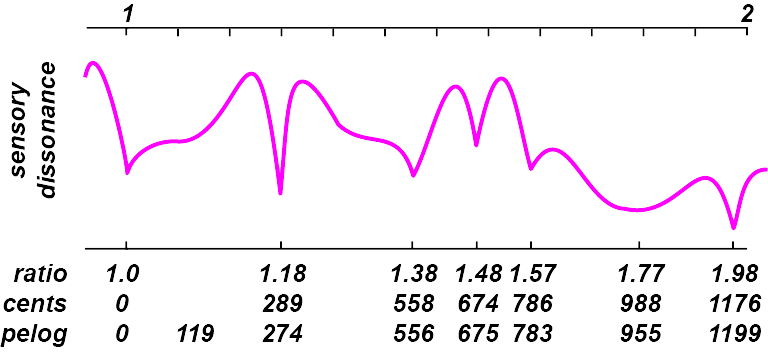

(Image source: Wikimedia Commons)
A comprehensive list of tunings and temperaments (currently more than 4600 files) can be found in the Scala Archive.
Tuning, Timbre, Spectrum, Scale
In 1998, the American music theorist and professor of electrical engineering Richard Sethares wrote a book titled Tuning, Timbre, Spectrum, Scale (Sethares, 2005) in which he focussed on the interdependence of consonance/dissonance and timbre. A strinking example for this is how the structure of a scale depends on the spectral content of the sonorities employed. If a sound features a stretched spectrum obtained by this formula (S being the stretch factor; 2 for harmonic series),
\begin{equation} f_n(stretched) = f_0 S^{(\frac{n}{log(2)})} \end{equation}
a candence made of this sound also asks for the scale to be stretched by the same amount. Otherwise, the chords and their progression will sound out of tune. This is due to the lining up of the partials when playing the spectra simultaneously and sequentially.
There are four scenarios to be considered:
- Neither the spectra nor the scales are stretched: all sounds in tune
- The spectra are stretched: the chords will sound dissonant
- The scale is stretched: the chord progression sounds out of tune
- Both spectra and scale are stretched: the chords and their progression sound smooth.
Note that depending on the stretch factor, chords may still sound strange and wanting. This is explained by the fact that, due to the brain’s ability to infer a virtual fundamental (f0), partials forming a harmonic spectrum (and - to lesser degree - tones forming a chord) will cause the sensation of a fundamental even though it may be absent from the spectrum. With stretched spectra, this virtual fundamental may not form a harmonic relationship with the members of the chord, adding to its inharmonicity.
Harmony and Meter
In Western tonal music, chord progressions follow certain syntactic rules particularly in cadences and sequences. Consequently, the meaning of a chord depends on its position on a weak or strong beat. Consider the sonority G-C-E-G commonly referred to as a second inversion 6-4 chord. If positioned on the downbeat of a measure, it is perceived as cadential 6-4 chord, first resolving to the dominant and then finally to the tonic. If positioned on a weak beat between a subdominant and its first inversion it is to be labeled as a passing 6-4 chord with no need to resolve any of its pitches.
Harmony and Gestalt
Intervals and chords are often related to the harmonic series. The major triad has throughout history been explained as representative of the 4/5/6 relationship. The derivation of minor chord, in turn, has been more controversial. Some consider it a representation of the 10/12/15 relationship while others argue that it actually stems from the subharmonic series, the inversion of the harmonic series - with the same relationship of the ordinal numbers 4/5/6 as the major chord. While chords taken from the subharmonic series may still be considered stable, they often lack a fundamental quality related to the perception of a virtual fundamental and, therefore, sound less resonant. In classical and contemporary avantgarde music sonorities are too complex to be derived from either the harmonic or subharmonic series. Instead, they ought to be regarded as hierarchical gestalts of gestalts where aspects such as virtual fundamental, voicing, sensory dissonance, syntax and context come into play.
Harmony in the 20th/21st Centuries
Tension and Release
The progression of harmony from consonance through dissonance and back to consonance can be abstracted and seen as a buildup of tension and a release of that tension. The serialist composers of the post-war period (Boulez, Stockhausen, etc.) gave up the ability to create tension and release through harmonic progression as they abandoned the sonorities and harmonic syntax of the past. The generation to follow (Grisey, Murail, Saariaho) sought new ways of creating tension and release without returning to the rules of the past. In her article Timbre and harmony: interpolations of timbral structures, Kaija Saariao proposes a “sound / noise axis” that could replace the tonal system of consonance / dissonance as a way of creating tension and release (Saariaho, 1987). This is heared clearly in the opening seconds of her composition Nymphea for string quartet and electronics—here, the performers alternate between normal playing and noisy extended techniques such as playing on the bridge (listening example 3).
Listening example 3. The opening minute of Kaija Saariaho’s Nymphea for string quartet and electronics.
[PAGE FROM SCORE HERE]
In works such as Gérard Grisey’s Partiels and Tristan Murail’s Gondwana, the composers create a relationship between harmonicity and inharmonicity. In this case, the concept of harmonicity refers to similarity to the harmonic series. In Partiels, the opening sonority - a harmonic series derived from the acoustical analysis of a bass trombone - is gradually transformed into an increasingly inharmonic sonority by gradually placing the highest pitches into lower octaves. In figure 9.14, the top graph is a sonogram of the opening 2’30” of Partiels and the bottom is a plot of the roughness (see the unit on consonance and dissonance) of the sonority over time created using a modified version of Richard Parncutt’s algorithm (Parncutt, 1989).
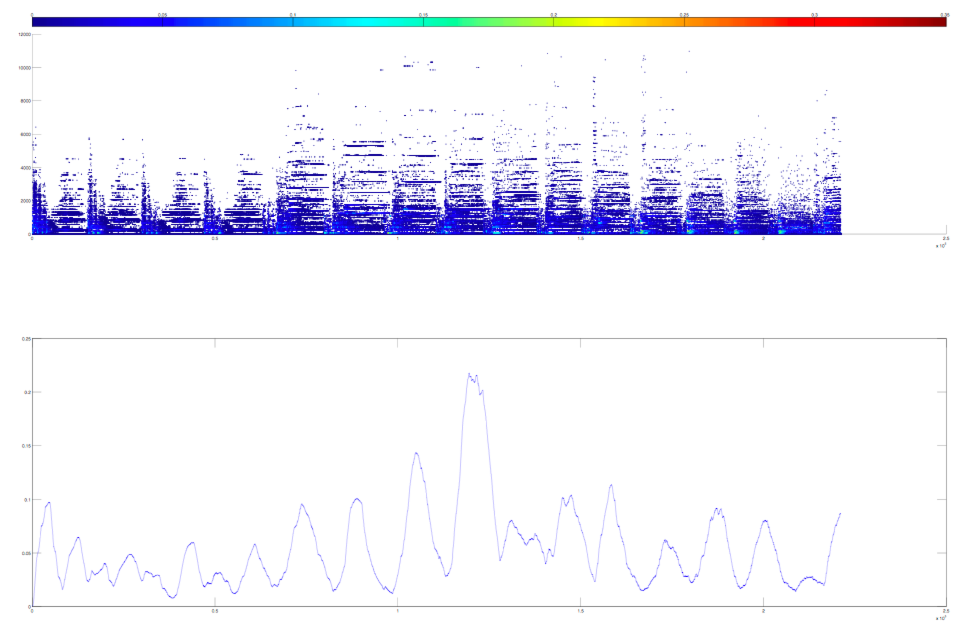
Listening example 4. The first 3’40” of Grisey’s Partiels.
Although Grisey uses a very different system of harmony in Partiels, one can still see a constant transition between consonance and dissonance or tension and release. About this issue, the composer writes in his own words:
Two traits characterize the development of sounds: periodicity and the overtone spectrum. These elements, which are very easy to identify, give the piece continuity and a dynamic that corresponds rather closely to the cyclical form of human respiration: inhalation, exhalation and rest or tension / collapse — relaxation — collection of energy.
In the following demo, the roughness of a sound file can be calculated in realtime.
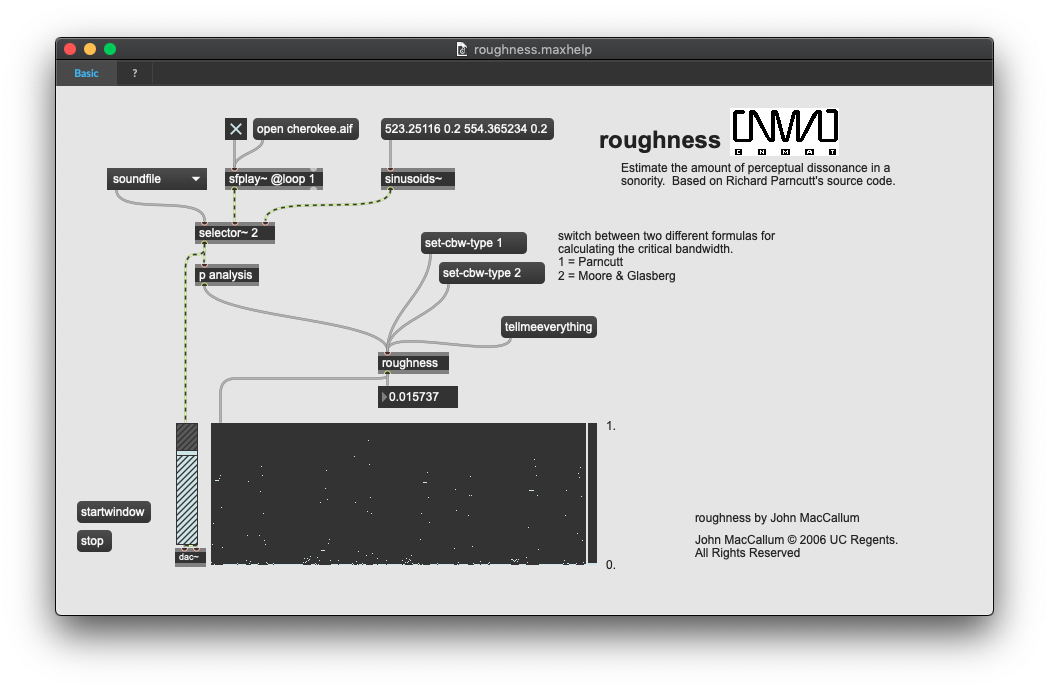
Harmony, Timbre and Transformation
The opening section of Partiels raises an interesting question: is there a difference between a chord and a timbre? In this case, it would seem that Grisey constructed a chord out of the elements of a timbre. But, if a timbre is made up of a series of pitches, how is it different from a chord? In most western classical music prior to the 20th century, harmony and timbre were considered two separate elements—the orchestration of a sonority could be done in many different ways and was often considered a subjective, surface-level detail. However, in the 20th century, composers such as Olivier Messiaen began to think of timbre and harmony as inseparable, and it is likely that Grisey would refer to the opening sonority of Partiels as a timbre rather than a chord.
A novel feature of Partiels is the idea of gradual timbral / harmonic evolution. In the past, harmonic change and movement to new key areas was largely a discrete event, however, here, by only changing a few notes at a time by placing them in different octaves, Grisey creates a smooth transformation from one sonority to another. David Wessel has developed a Max object that facilitates gradual timbral transformation. Here, a timbre is created using a large bank of sinusoidal oscillators and a gradual transformation to a new timbre is done by changing the frequency of one oscillator at a time. Download the following patch to experiment with different timbral transformations.
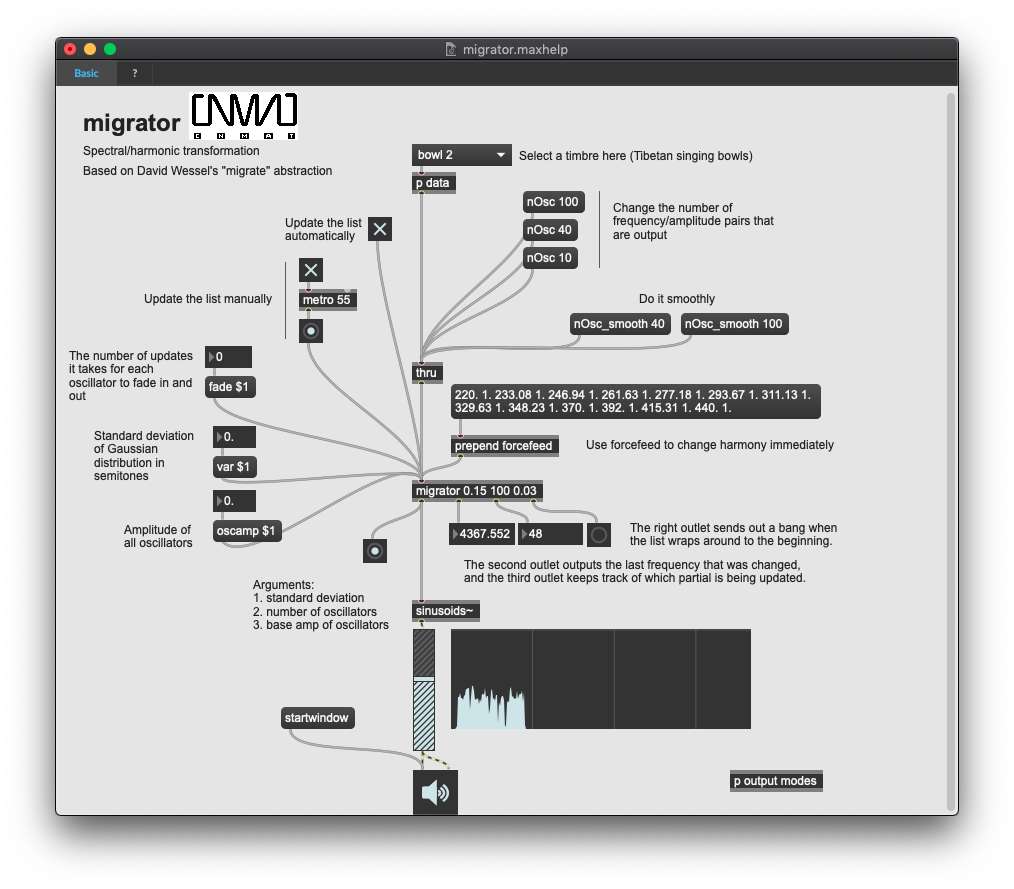
Quiz
In what way does quarter-comma meantone temperament relate to 31TET?
How does temperament affect harmony and harmonic progression?
Describe the differences and similarities between harmony and timbre.
What are some ways in which recent composers have sought to create tension and release in music without going back to the tonal system of the past?
Why is the context in which a sonority appears important?
References
- Aldwell, E. & Schachter, C. & Cadwallader, A. “Harmony and Voice Leading”. Cengage Learning. 2018.
- Barbour, J.M. “Tuning and temperament: A historical survey”. Courier Corporation. 2004.
- Blackwood, E. “Twelve microtonal etudes: for electronic music media, op. 28”. G. Schirmer. 1982.
- Bohlen, H. “13 Tonstufen in der Duodezime”. Acustica, 39(2): 76-86. 1978.
- von Helmholtz, H. “On the sensations of tone”. Courier Corporation. 2013.
- Grisey, G. “Tempus ex machina: a composer’s reflections on musical time”. Contemporary Music Review, 2(1): 239-276. 1987.
- Loui, P. & Wessel, D.L. & Hudson Kam, C.L. “Humans rapidly learn grammatical structure in a new musical scale”. Music Perception, 27(5): 377-388. 2010.
- Müller, N.-L. & Orlandatou, K. & Hajdu, G. “Starting Over – Chances Afforded by a New Scale”. In 1001 Microtones, Stahnke, M. and Safari, S. (Eds.). Von Bockel, 127–172. 2014.
- Parncutt, R. “Harmony: A Psychoacoustical Approach”. Springer-Verlag, Berlin. 1989.
- Partch, H. “Genesis Of A Music: An Account Of A Creative Work, Its Roots, And Its Fulfillments”. Da Capo Press. 1979.
- Saariaho, K. “Timbre and harmony: Interpolations of timbral structures”. Contemporary Music Review, 2(1): 93-134. 1987.
- Sabat, M. & von Schweinitz, W. “The Extended Helmholtz-Ellis JI Pitch Notation”. Plainsound Music Edition. 2004.
- Sethares, W.A. “Tuning, Timbre, Spectrum, Scale”. Springer Science & Business Media. 2005.
- Wessel, D.L. “Timbre space as a musical control structure”. Computer Music Journal, 3(2): 45-52. 1979.
Authors
Topics
- Scale
- Harmony
- Microtonality
- Timbre
- Inharmonicity
- Roughness
